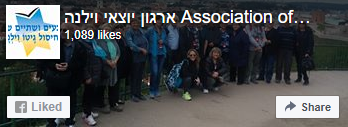Religious Life in the Ghetto
In October 1938, a short time after WWII had broken out and following the Molotov-Ribbentrop agreement, Vilna was handed over to the Russians who returned control to the Lithuanians. When the governing body changed hands, the yeshivas and Jewish cultural institutions were closed. Torah studies were held clandestinely.
On 24th June 1941, Vilna had been occupied by the Germans. Two and a half months later, on 6th September, the Vilna Jews were confined in the ghetto.
In his article, Dr. Meir Dvorzetski describes religious life in the Vilna Ghetto. He listed thirty rabbis and Torah scholars who lived and worked in the ghetto. Some of them were murdered during the Aktions on 13th July 1941, called the Day of the Rabbis, and some were tortured and murdered at other times.
There were three midrashim (study houses) in the ghetto: the butchers’ midrash located at 5 Butchers’ Lane; Shaulke’s midrash at 5 Shavli Street and the Yogiche Kloize (Midrash) at 1 Shavli Street. Students would study and pray in the midrashim from 4.30 in the morning until the curfew started at 21.00 in the winter or 22.00 in the summer). Rabbi Gershon Liebman (Bilenki) was one of the rabbis active in the ghetto. He established the Beit Yosef yeshiva in the ghetto in 1942, where over 30 boys studied. In 1943, he was transferred to camps in Estonia and Latvia, before being sent to a camp in the vicinity of Bergen Belsen, from where he was released. He then established a yeshiva in the DP camp. He moved to France after the war and established the Novardok Yeshiva. Rabbi Liebman died in Paris and 1997 and was buried in Jerusalem.
Rabbi Yisrael Ze’ev Gustman, called the Last Vilna Gaon, was born in 1910. When he was 21, Rabbi Chaim Ozer Grodzinski appointed him as the Rabbi of Shnipishuk (a suburb of Vilna). He replaced his father-in-law, Rabbi Meir Bassin, (head of the Ramailes Yeshiva) as the dayan of the Beit Din of Vilna. Rabbi Gustman survived the Holocaust, cut off his beard and was the last rabbi left alive in the Vilna Ghetto. At one stage, he ordered everyone who could, to flee the ghetto. After the war, Rabbi Gustman returned to Vilna. As the last rabbi to have survived, he felt responsible for taking care of the displaced persons and took care of all matters pertaining to religion and kashrut. He also had to cope with difficult questions about marriage and freeing agunot (religious women whose husbands refuse to grant them a divorce). About a year after the war, on the first day of Pesach, a Jewish-Communist Commissar warned him that he was going to be sent to Siberia. He fled with his wife and daughter to Israel after managing to cross the borders of Czechoslovakia and France. Most of the city’s rabbis were murdered at the start of the German occupation so only a few rabbis were left in the ghetto. A synagogue and two midrashim (houses of study) were in operation and prayers were held in all of them. There were also yeshivas, two schools and a ‘Cheder’ (a traditional elementary school teaching the basics of Judaism and Hebrew) in the midrashim.
It was very difficult to maintain a proper religious way of life. First of all, the Shabbat (the Jewish Sabbath) was a normal work day. Even the most religious were forced to desecrate the Shabbat and only did this as ‘pikuah nefesh’ (permission to save a life during the Sabbath). Those keeping kosher were forced to give up eating meet almost completely, since mostly non-kosher horse meat was available.
Despite all this, the Jewish festivals were kept as much as possible: Matza (unleavened bread) was prepared during the Passover, and the Judenrat allocated a portion of matza for everyone – between a quarter to half a kilo for all the festivals and, according to Karok, “there was no home in the ghetto without matza”: 12th September 1942, Rosh HaShana (Jewish New Year), was notable for good spirits and visiting friends and family, and the children sent out New Year cards; Yom Kippur (the Day of Atonement) was spent remembering the Aktions of the previous year and the thousands who had been murdered, and ’Kol Nidre’ (a prayer sung in Jewish synagogues at the beginning of the service on the eve of Yom Kippur) was sung in a crowded theater hall in addition to the many private ‘minyans’ (a quorum of ten Jewish adults required for certain religious obligations); for Succoth (the Feast of Tabernacles) booths were erected and those who worked outside the ghetto managed to get hold of lulavs (a closed frond of the date palm tree) and etrogs (citrons); at Chanukah (Festival of Lights), the children played with dreidels (spinning tops), parties were held and there was even a Chanukah assembly held by the religious. There was also a party held by the Hebrew Alliance School as well as celebrations in the boarding schools and children’s clubs. At Purim (a Jewish holiday which commemorates the saving of the Jewish people in the Persian Empire from Haman) they held many parties with wooden rattles and addresses about the festival.
Children were given the option of studying in religious schools. The teacher Eliezer Goldberg established a religious seminary where he used to read a chapter about Jewish history every week. On 24th January, 1943, a festive closing of the Kiddushin Tractate was held with the participation of representatives of the ghetto administration, in which blessings were given and prayers were held.
From: Aharon Einat, Daily Life in the Vilna Ghetto.

